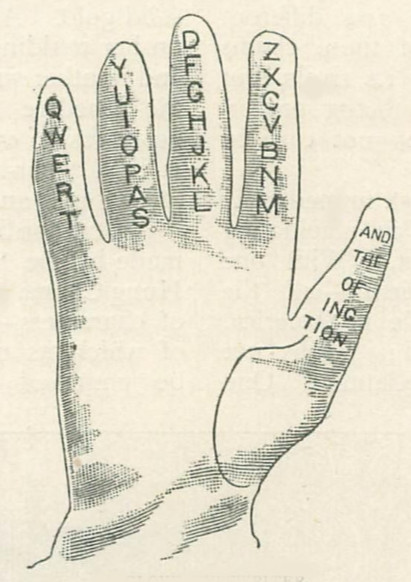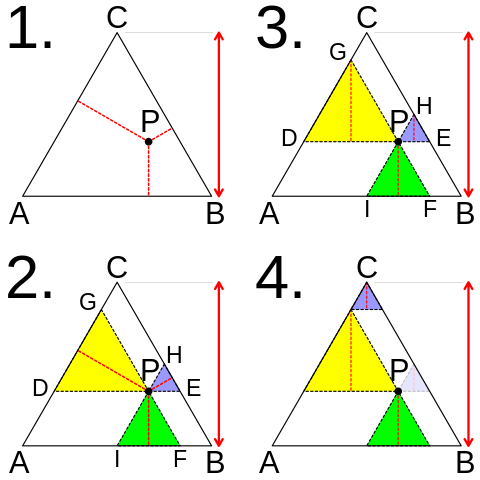
- To burn up is to burn down.
- Litotes is an anagram of T.S. Eliot.
- 1012658227848 × 8 = 8101265822784
- Three U.S. presidents died on July 4.
- “Grasp the subject, the words will follow.” — Cato the Elder


From an 1897 Strand article: The “typewriter glove” was “a contrivance of wash-leather, upon which were embossed a set of rubber types. ‘Caps’ were on the left hand. Small letters on the right. The ink was supplied by a couple of pads, fixed to the palms of the gloves; and the alternate opening and shutting [of] the hands was supposed to bring it in contact with the type.
“Then, all that was necessary was for the operator to dab the impression of the particular letter he desired to use upon the paper in front of him. How the alignment was to be preserved, with even a tolerable degree of accuracy, the inventor did not deign to explain.”
(C.L. McCluer Stevens, “The Evolution of the Typewriter,” Strand 13:6 [June 1897], 649-656.)
In 1590 Emperor Rudolf II commissioned Flemish painter Joris Hoefnagel to illuminate the Mira calligraphiae monumenta, an illustration of various scripts that had been begun 15 years earlier by court calligrapher Georg Bocskay.
The book contains a tiny demonstration of Hoefnagel’s skill in trompe-l’œil. On one page he painted a Maltese cross, a type of flower, depicting it as though the plant’s stem passes through a slit in the paper. On the overleaf he continues the idea — the foregoing text and images can be discerned through the page, and Hoefnagel has faithfully painted in the flower’s “stem” as if the insertion were real. It’s the only painted element on this side of the page.

It appears that there was a club and the president decided that it would be nice to hold a dinner for all the members. In order not to give any one member prominence, the president felt that they should be seated at a round table. But at this stage he ran into some problems. It seems that the club was not all that amicable a little group. In fact each member only had a few friends within the club and positively detested all the rest. So the president thought it necessary to make sure that each member had a friend sitting on either side of him at the dinner. Unfortunately, try as he might, he could not come up with such an arrangement. In desperation he turned to a mathematician. Not long afterwards, the mathematician came back with the following reply. ‘It’s absolutely impossible! However, if one member of the club can be persuaded not to turn up, then everyone can be seated next to a friend.’ ‘Which member must I ask to stay away?’ the president queried. ‘It doesn’t matter,’ replied the mathematician. ‘Anyone will do.’
This problem, dubbed “Le Cercle Des Irascibles,” was posed by René Sousselier in Revue Française de Recherche Opérationelle in 1963. The remarkable solution was given the following year by J.C. Herz. In this figure, it’s possible to visit all 10 nodes while traveling on line segments alone, but there’s no way to close the loop and return to the starting node at the end of the trip (and thus to seat all the guests at a round table). But if we remove any node (and its associated segments), the task becomes possible. In the language of graph theory, the “Petersen graph” is the smallest hypohamiltonian graph — it has no Hamiltonian cycle, but deleting any vertex makes it Hamiltonian.
(Translation by D.A. Holton and J. Sheehan.)
British artist Martin Creed introduced a controversial installation in 1995: an empty room in which the lights turn on and off at 5-second intervals.
Critic David Lee said, “Last year, the Tate was scraping the barrel. This year they are scraping the scrapings … A light being switched on and off is not a good work of art.” But when Creed submitted the work for the Turner Prize, the jury praised its “strength, rigour, wit and sensitivity to the site.”
Work No. 227: The lights going on and off was followed in 2000 by Work No. 254: The lights in a building going on and off — in which a building’s lights go on or off each second.

Pick any point in the interior of an equilateral triangle and draw a perpendicular to each of the three sides. The sum of these perpendiculars is the height of the triangle.
That’s Viviani’s theorem. This visual proof is by CMG Lee:
The converse of the theorem is also true: If the sum of the perpendiculars from a point inside a triangle to its sides is independent of the point’s location, then the triangle is equilateral.
Long-short-short, long-short-short
Dactyls in dimeter,
Verse form with choriambs
(Masculine rhyme):
One sentence (two stanzas)
Hexasyllabically
Challenges poets who
Don’t have the time.
— Roger L. Robison
I don’t normally follow sports, but this seems worth remarking: Tonight Danny Jansen is set to become the first baseball player to play for both teams in the same game.
Jansen was in the lineup for the Toronto Blue Jays when they faced Boston on June 26, a game that was suspended because of rain and scheduled to be made up on Monday. In the meantime, he was traded to Boston, and Red Sox manager Alex Cora has said he will put Jansen in the lineup when the game resumes.
Jansen had been at bat when the game was suspended and will likely be behind the plate as catcher when the Blue Jays send a pinch hitter to finish the at-bat. So he’ll actually play both sides of the same at-bat.
Eric Money is the only NBA player to score for two teams in one game, though others have played for both sides.
(Via MetaFilter.)
pluvial
adj. relating to rainfall
A little tap at the window, as though some missile had struck it, followed by a plentiful, falling sound, as light, though, as if a shower of sand were being sprinkled from a window overhead; then the fall spread, took on an order, a rhythm, became liquid, loud, drumming, musical, innumerable, universal. It was the rain.
— Proust, Swann’s Way